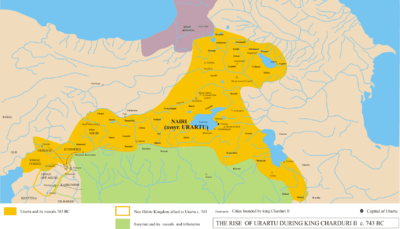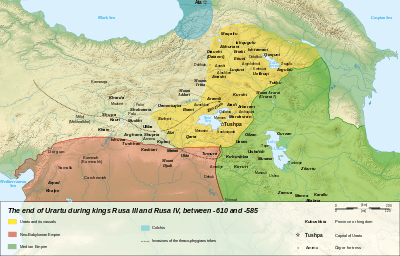Èrs people
The Èr people, also known as Èrsh or (in Georgian works) the Hers, are a hypothetical ancient people inhabiting northern modern Armenia, and to an extent, small areas of northeast Turkey, southern Georgia, and northwest Azerbaijan. Most of their history is constructed based on linguistic (primarily based on placenames) data, compared to historical trends in the region and historical writings, such as the Georgian Chronicles or the Armenian Chronicles. They were a constituent of the state of Urartu, which either incorporated or conquered them during the 8th century BCE. Their relation to the main Urartians is unknown. Linguistically, based on placenames, some scholars argue they were a Nakh people.[1]
Language and history
According to Amjad Jaimoukha, their language was a Nakh language, and the Èrs were a Nakh speaking regional "nation-tribe" within Urartu. Proposed Nakh placenames include:

- Erebuni, composed of the Èrs' ethnonym plus buni, a Nakh root meaning shelter or home, which also gave rise to the modern Chechen word bun (pronounced /bʊn/), meaning a cabin, or small house. Hence, Erebuni meant "the home of the Èrs". Hence, "Erebuni" would mean "home (shelter) of the Èrs".[2] It corresponds to modern Yerevan.[3]
- Erashki Gorge (the Arax River), once again including the Èrs' ethnonym, while it has been argued that the final component is linked to the Nakh and Hurrian hydronym-forming suffix, -khi (by which were also formed several other proposed interpretations of hydronyms in Nakh territories at the time, including Lomekhi/Lam-Khi, the Ancient name of the Terek thereby interpreted as meaning "Mountain River".[4]
- Yeraskhadzor -- same root as above, with the addition of the Armenian -dzor toponym, meaning gorge.[5]
- Ereta -- the name of Lake Sevan in the Georgian Chronicles, written by Leonti Mroveli, which is held to be the boundary of the land of "Targamos", the mythical ancestor according to Mroveli of various Caucasian peoples including the Nakhchmateans (held to be Nakh and "progenitors of the Nokhchii" (Chechens) by some scholars such as Jaimoukha.[6]) and Kavkasos and his descendant "Dzurdzuk".[7]
According to the "Alarodian" hypothesis, which links the Nakh and other Northeast Caucasian languages with Hurrian and Urartian, and is advocated by some linguists such as Sergei Starostin, it would also be more distantly related to the language of the Ers' former rulers, the Urartians.[8]

Jaimoukha notes the close proximity to the South is the "Nakhchradzor" gorge, suggested as an old home of the Dzurdzuks.[9] During the time of the kingdom of Urartu, there was a northern region near the Yerashkhadzor gorge and a little northwest of Erebuni called "Eriaki".
Jaimoukha argues that there was a migration out of former Urartian territories, north into the Caucasus, after Urartu broke up, and uses ancient writings to support the theory.[10] Strabo wrote that the "Gargareans", considered by Jaimoukha to be a "proto-Nakh" or "Nakh-related people" migrated north at this time; Jaimoukha links their ethnonym to the Nakh root gergara, meaning kindred,[11][12] while the Georgian Chronicles of Leonti Mroveli states that "many Urartians [i.e. inhabitants of Urartu], as their state collapsed, returned to the Transcaucasus, which had mostly now become a Kartlian [i.e. Kartli, the center of the Georgian Iberian state] domain", and has mythical Targamos and his progeny, which include among others the putative ancestors of the Nakh such as Targamos' grandson "Durdzuk" and the "Nakhchmateans", migrating into the Caucasus; the latter of which is said to have established the ancient Chechen state of "Dzurdzuketia", so named in Georgian, in what is now Southern Chechnya.[13] Jaimoukha connects the origin of the name "Durdzuk" to a Durdukka, a town on the shores of Lake Urmia.[14]
Apparently, Xenophon visited Urartu in 401 BCE, and rather than finding Urartians, he only found pockets of Urartians, surrounded by Armenians.[15][16] These Urartians, as modern scholars infer, were undergoing a process of assimilation to Armenian language and culture.
See also
- Nakh peoples
- Northeast Caucasian people
- Northeast Caucasian languages
- History of Chechnya, has a section referring to the fate of the Èrs and other Urartians
- Hereti
- Balakan
References
- ↑ Jaimoukha, Amjad. The Chechens. Page 30-32
- ↑ Jaimoukha, Amjad. The Chechens: A Handbook. Page 30
- ↑ See Israelyan, Margarit A (1971). Էրեբունի: Բերդ-Քաղաքի Պատմություն (Ēryebowni: Byerd-Kaghaki Patmowt'hown, Erebuni: The History of a Fortress-City) (in Armenian). Yerevan, Armenian SSR: Hayastan Publishing Press. pp. 8–15.
- ↑ Jaimoukha, Amjad. The Chechens: A Handbook. Page 30, 271
- ↑ Jaimoukha, Amjad. The Chechens: A Handbook. Page 30
- ↑ Jaimoukha, Amjad. The Chechens: A Handbook. Page 30-31
- ↑ Jaimoukha, Amjad. The Chechens. Page 30-31
- ↑ Igor M. Diakonoff, Sergei A. Starostin. "Hurro-Urartian and East Caucasian Languages", Ancient Orient. Ethnocultural Relations. Moscow, 1988, pp. 164-207 http://starling.rinet.ru/Texts/hururt.pdf
- ↑ Jaimoukha, Amjad. The Chechens: A Handbook. Routledge Curzon: Oxon, 2005.
- ↑ Jaimoukha, Amjad. The Chechens: A Handbook. Page 28: "The most probable theory on Nakh ancestry is that it was the (re-)union of the Caucasian Nakh, the location of whose original domicile is still a moot point, and some of the Urartian remnants of the break-up of the kingdom of Urartu, with the Trans-Caucasus being the most likely locality at which this fusion took place." . Page 31: "Genetic relatedness between the Vainakh and Hurrian-Urartian languages led to the hypothesis that elements of the Urartians migrated across the Caucasus after the breakup of their state, which is borne out by some writings of antiquity."
- ↑ Jaimoukha, Amjad. The Chechens: A Handbook. Page 31
- ↑ Jaffarov, Y., ‘The Gargar Problem and Emerging of Writing in Caucasian Albania’, paper presented at Annual Conference of the Central Eurasian Studies Society, 2001. Cited in Jaimoukha, The Chechens
- ↑ Jaimoukha, Amjad. The Chechens: A Handbook. Page 31
- ↑ Jaimoukha, Amjad. The Chechens: A Handbook. Page 30: "Dzurdzuks (Durduks: from the town of Durdukka on Lake Urmia in northwest Iran)"
- ↑ Jaimoukha. Chechens. p. 29
- ↑ http://www.asor.org/pubs/nea/back-issues/ba/zimansky.html